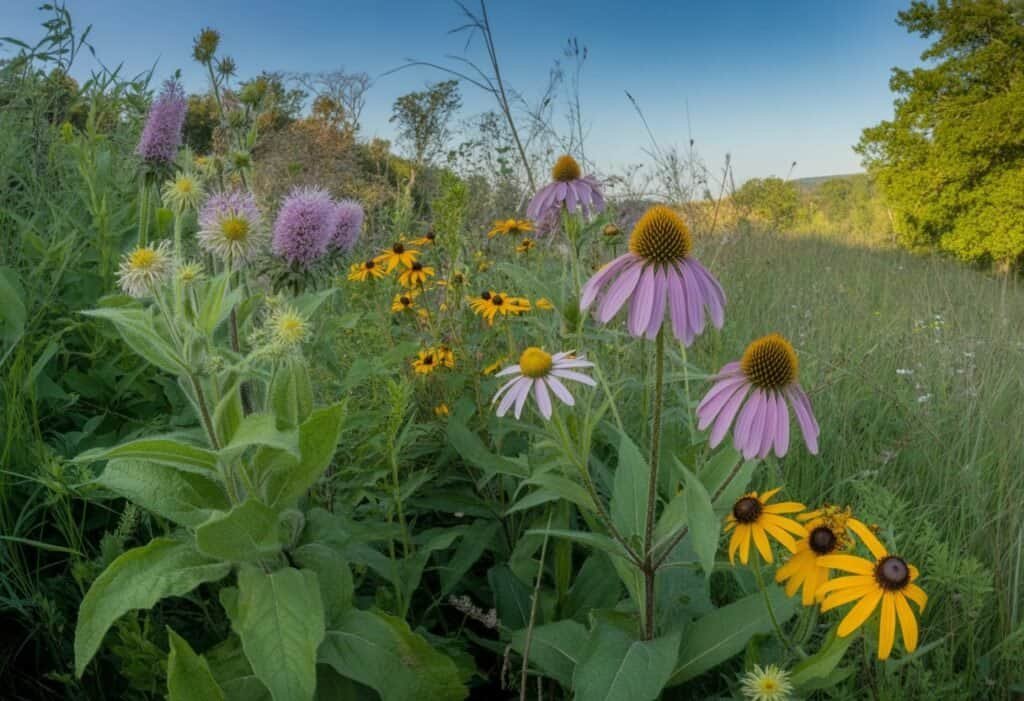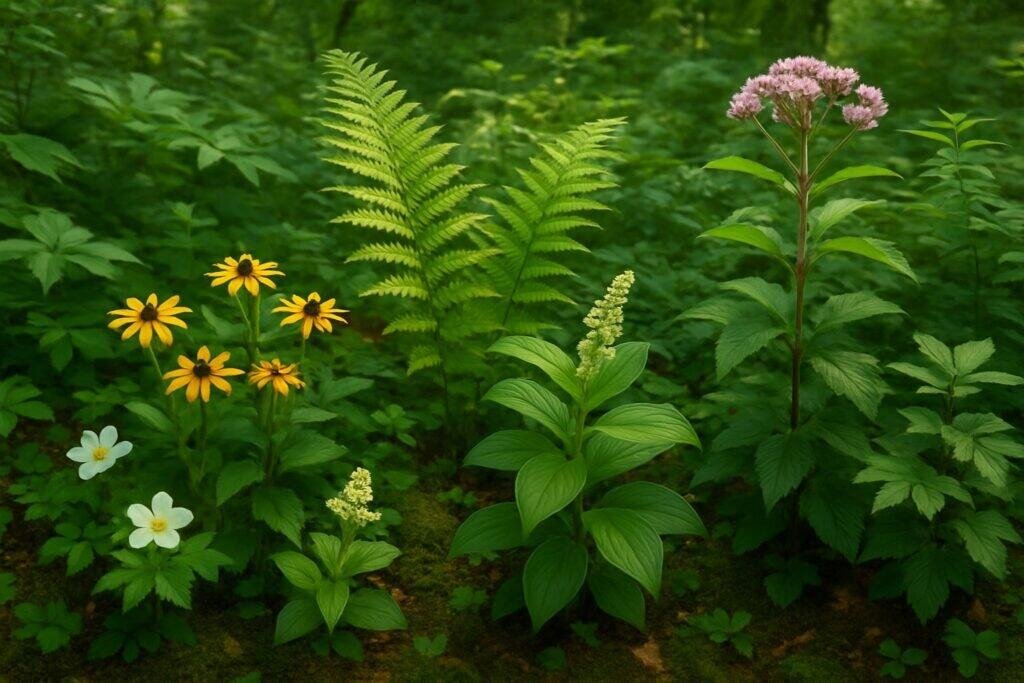Pennsylvania’s landscape boasts a rich variety of native plants that thrive in local soil and climate conditions. These indigenous species have adapted over thousands of years to the region’s environment, creating harmony with local wildlife and ecosystems.
Native plants need less maintenance. They support local pollinators and help preserve Pennsylvania’s natural heritage while creating sustainable landscapes.
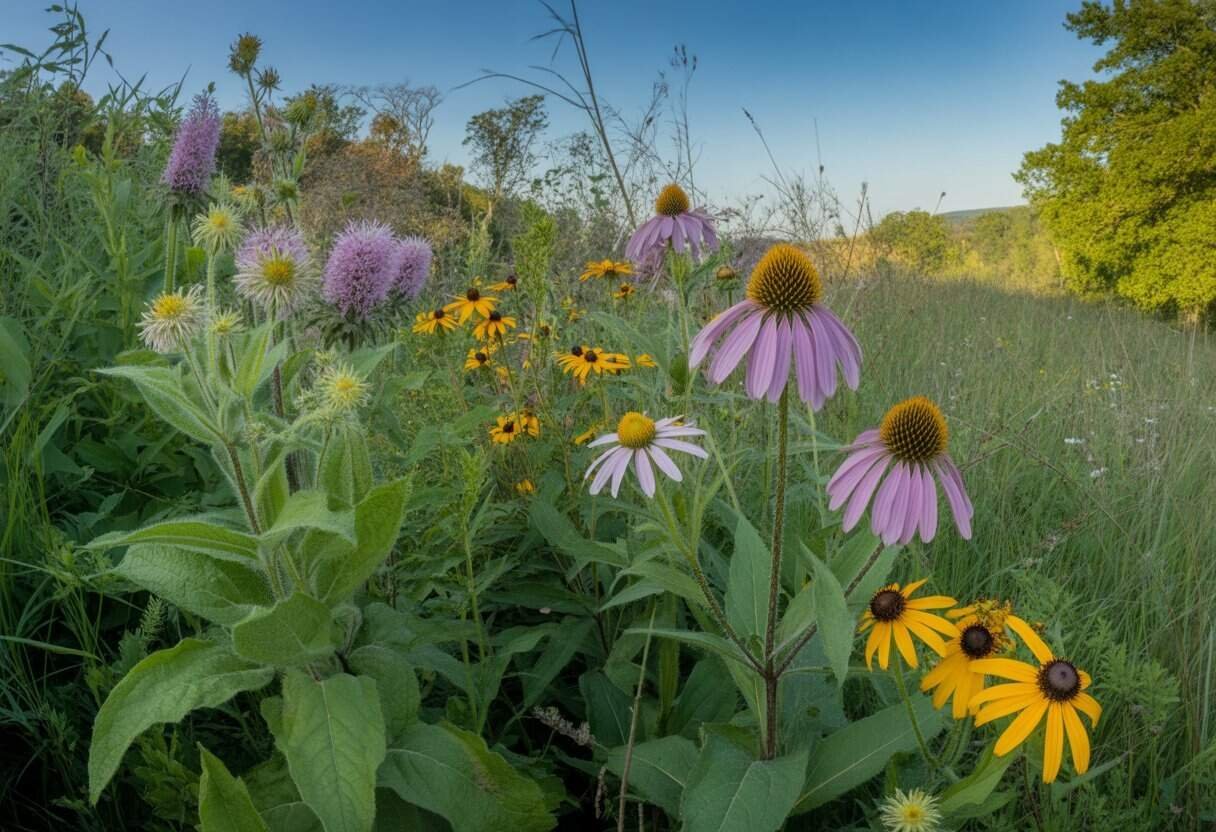
Native plants come in all shapes and sizes, from towering oak trees to delicate wildflowers on forest floors. They can transform ordinary yards into vibrant habitats that attract butterflies, birds, and beneficial insects.
Many Pennsylvania gardeners are choosing these botanical treasures instead of exotic species. Exotics often need more water, fertilizer, and pest control.
Key Takeaways
- Native Pennsylvania plants need less maintenance and support local wildlife and pollinators.
- Indigenous species like oak trees, black-eyed Susans, and purple coneflowers thrive in Pennsylvania’s climate without extra water or fertilizers.
- Adding native plants helps combat invasive species and preserves Pennsylvania’s ecological balance.
Understanding Native Plants in Pennsylvania
Pennsylvania’s landscape features a rich diversity of native plant species. These plants form the foundation of local ecosystems and provide essential benefits to wildlife and people.
Defining Native Plant Species
Native plants in Pennsylvania are species that grew in the region before European settlement. These plants evolved alongside local wildlife, soil, and climate patterns.
Examples include Eastern Redbud, Black-eyed Susan, and Mountain Laurel, Pennsylvania’s state flower. Native plants have developed close relationships with the land.
They’ve adapted to Pennsylvania’s seasonal changes, rainfall, and soil types. This adaptation means they usually need less maintenance, fertilizer, and water than non-native species.
The Pennsylvania Department of Conservation and Natural Resources recognizes over 2,100 native plant species in the state. These range from towering trees like the White Oak to delicate wildflowers such as Virginia Bluebells.
Importance of Native Plants in Local Ecosystems
Native plants form the foundation of Pennsylvania’s ecosystem. They provide food and habitat for native insects, birds, and other wildlife.
For example, native oak trees support over 500 species of caterpillars, which are essential food for nesting birds. Native goldenrod attracts pollinators like bees and butterflies.
These plants also improve soil health. Their deep roots prevent erosion, filter water, and improve soil structure.
During heavy rains, native plants help reduce flooding and water pollution. Native plant communities increase biodiversity across Pennsylvania.
They create resilient ecosystems that can better withstand environmental stresses like drought, disease, and climate change.
Distinction Between Native, Non-Native, and Invasive Plants
Native plants evolved in Pennsylvania’s ecosystems and support local wildlife. They exist in balance with their environment.
Non-native plants came from other regions or countries. Many non-natives are harmless but provide fewer benefits to local wildlife and may need more resources.
Invasive plants are non-natives that spread aggressively and harm ecosystems. Species like Japanese Knotweed and Purple Loosestrife outcompete native plants and disrupt natural processes.
Identifying these differences helps gardeners and land managers. Native plant gardens support more wildlife than gardens with mostly non-natives.
Removing invasive species restores ecosystem balance and protects Pennsylvania’s natural heritage.
Benefits of Planting Native Species
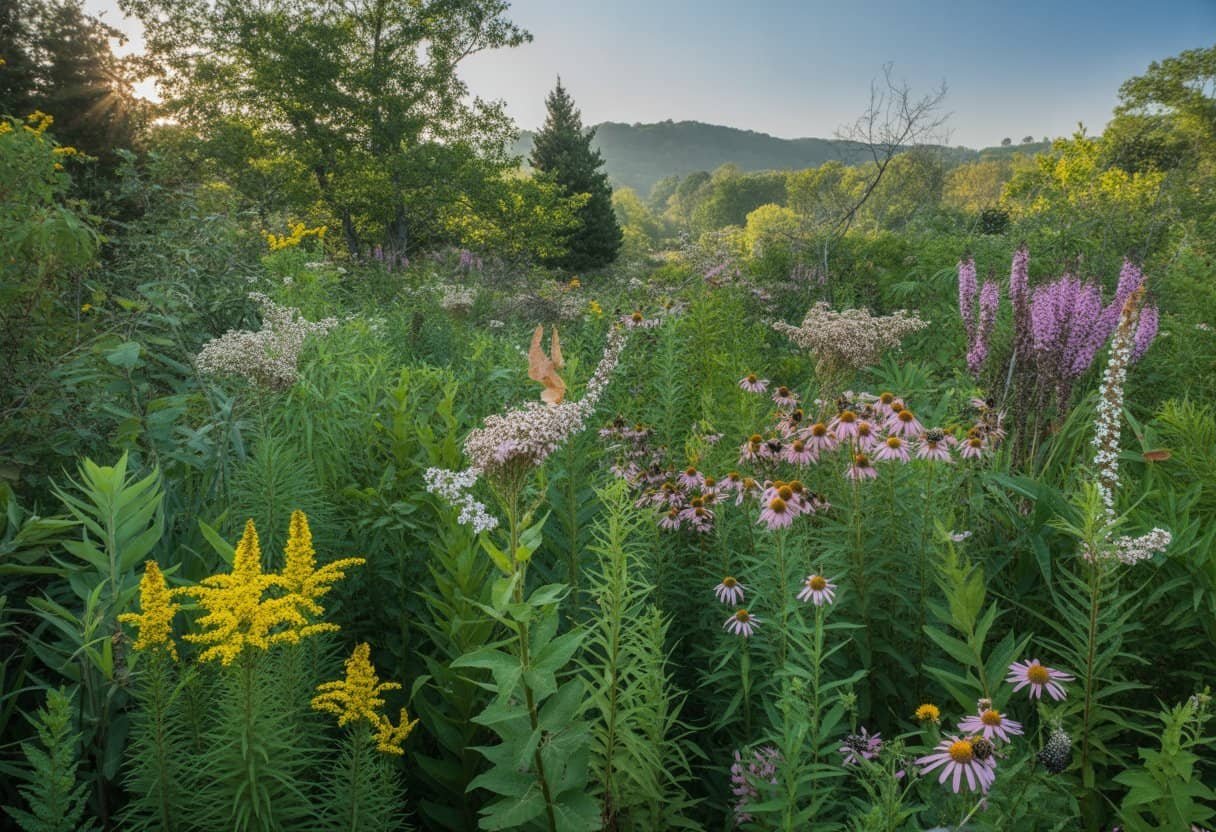
Native plants offer many advantages for Pennsylvania gardens and landscapes. They create sustainable environments that support local ecosystems with less work and fewer resources.
Supporting Wildlife and Pollinators
Native plants provide essential food and shelter for local wildlife. Pennsylvania’s native oak trees support many caterpillar species, which become food for birds and other animals.
Monarch butterflies depend on milkweed plants to lay their eggs. Without these native plants, monarchs cannot reproduce.
Native flowers like purple coneflower, black-eyed Susan, and bee balm attract bees, butterflies, and hummingbirds. These pollinators help gardens thrive and support food production.
Birds benefit from native plants. Cardinals and chickadees eat seeds from native flowers, while robins eat berries from spicebush and serviceberry.
Even small gardens with diverse native plants can become important stepping stones for wildlife in developed areas.
Enhancing Biodiversity
Native plants strengthen Pennsylvania’s ecosystem by maintaining genetic diversity. They preserve unique species that have adapted to local conditions.
When planted together, native species create complex habitats that support many forms of life. A single oak tree might host insects, birds, mammals, and fungi.
Native plant gardens help counter habitat loss from development. Urban and suburban native plantings create corridors for wildlife movement between larger natural areas.
Diverse native plantings protect against diseases and pests. Unlike monocultures, mixed native gardens don’t suffer complete devastation when one pest or disease strikes.
Native plant communities also improve soil health. Their deep roots add organic matter and support beneficial soil microorganisms.
Low Maintenance and Water Conservation
Native plants need much less care than non-native options. Once established, they rarely need watering, fertilizer, or pest control.
Their natural adaptations to Pennsylvania’s climate make them self-sufficient. Deep roots of native plants like switchgrass and little bluestem help them survive drought.
These roots can reach 15 feet underground, accessing water unavailable to shallow-rooted plants. Native plants conserve water by thriving on natural rainfall.
A landscape of native plants might need 70% less watering than conventional lawns and exotics. Maintenance costs drop with native plantings.
Less mowing, watering, and chemical treatments save both money and time. Native plants also help manage stormwater.
Their roots create soil channels that let rainwater soak in, reducing erosion and flooding.
Popular Native Plant Types in Pennsylvania
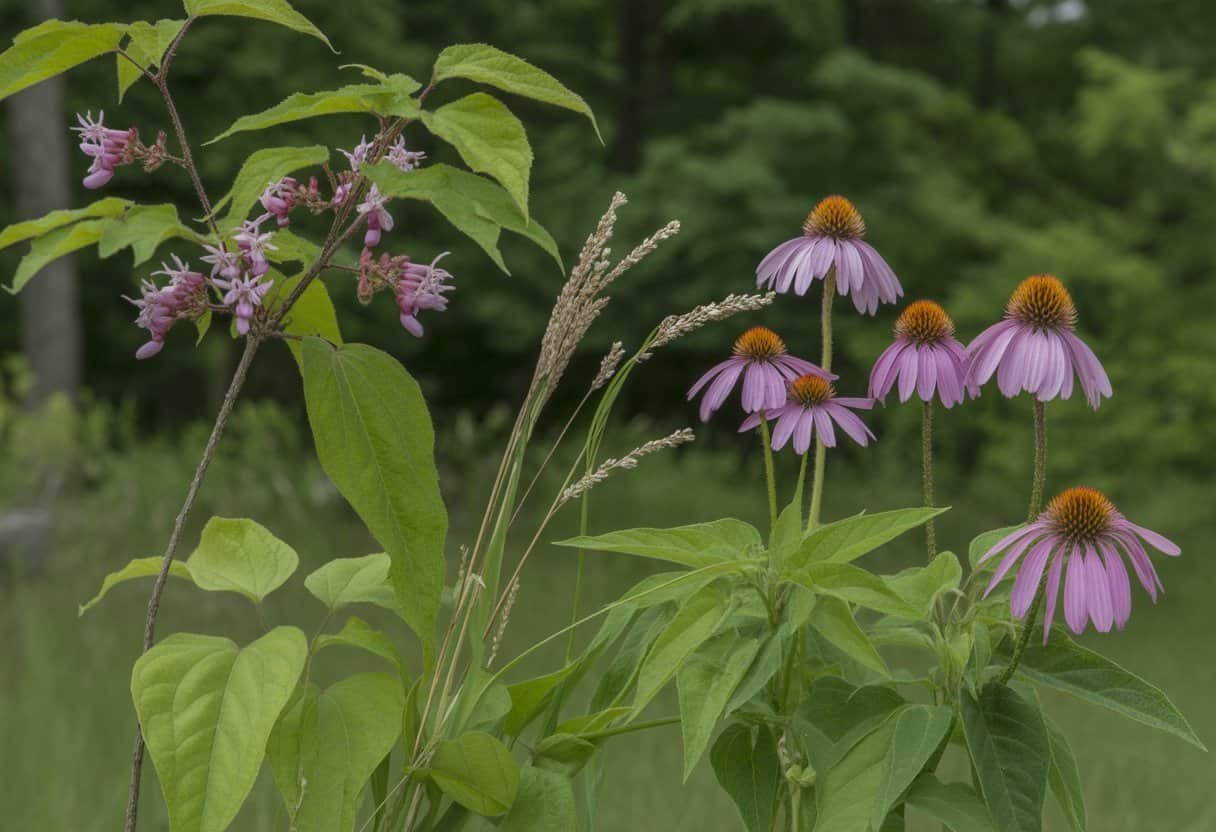
Pennsylvania’s landscape features diverse native plants that thrive in local soils and weather conditions. These plants support wildlife and need less maintenance than non-natives.
Native Shrubs
Red chokeberry (Aronia arbutifolia) stands out with white spring flowers and bright red fall berries. Birds love the berries, and deer usually avoid the plant.
Mountain laurel (Kalmia latifolia), Pennsylvania’s state flower, produces pink-white blooms in late spring. This evergreen shrub thrives in woodlands with acidic soil.
Lowbush blueberries (Vaccinium angustifolium) offer ecological benefits and tasty fruits. These compact shrubs produce white bell-shaped flowers and nutritious berries.
Other valuable native shrubs include:
- Winterberry (Ilex verticillata)
- Fragrant sumac (Rhus aromatica)
- Northern bayberry (Myrica pensylvanica)
These shrubs provide year-round interest with seasonal color and wildlife value.
Native Perennials
Wild bergamot (Monarda fistulosa) attracts pollinators with lavender flowers and aromatic leaves. This drought-tolerant perennial blooms through summer.
Black-eyed Susan (Rudbeckia hirta) brings golden yellow flowers from June through September. Its daisy-like blooms stand atop sturdy stems.
Butterfly weed (Asclepias tuberosa) serves as critical monarch butterfly habitat. Its orange flowers bloom from June to August, providing nectar for pollinators.
Pennsylvania’s native perennials often feature:
- Deep root systems that prevent erosion
- Drought tolerance once established
- Seasonal interest all year
- Wildlife support through food and shelter
Forbs and Groundcovers
Wild ginger (Asarum canadense) makes an excellent woodland groundcover with heart-shaped leaves. This low-growing plant forms dense patches in shady areas.
Pennsylvania sedge (Carex pensylvanica) thrives where grass struggles. Its fine texture creates a meadow-like look in dry shade.
Foamflower (Tiarella cordifolia) produces delicate white flower spikes above maple-shaped leaves. This groundcover blooms in spring and keeps attractive foliage all year.
Popular Native Groundcovers:
| Plant Name | Light Needs | Soil Preference | Height |
|---|---|---|---|
| Wild Ginger | Shade | Rich, moist | 4-8″ |
| Pennsylvania Sedge | Part shade | Dry to medium | 6-12″ |
| Foamflower | Shade | Rich, moist | 6-12″ |
| Woodland Phlox | Part shade | Medium | 8-18″ |
Noteworthy Native Trees
Eastern red cedar (Juniperus virginiana) provides year-round evergreen structure. This drought-tolerant conifer produces blue berries that feed birds.
River birch (Betula nigra) features peeling bark that adds winter interest. This tree tolerates both wet soils and drought.
Serviceberry (Amelanchier spp.) offers four-season appeal with spring flowers, summer berries, fall color, and attractive winter bark. The berries attract birds and can be eaten by people.
American hornbeam (Carpinus caroliniana) thrives in shady areas. Its muscle-like bark and strong branches add landscape interest all year.
Choosing the Right Native Plants
Select native plants for your Pennsylvania garden by considering soil, climate, and your preferences. Native plants that match your growing conditions will thrive with little maintenance and offer maximum ecological benefits.
Matching Plants to Soil Type
Pennsylvania soils range from acidic to alkaline and from clay to sandy loam. Test your soil before planting.
Many native plants like Black-eyed Susan (Rudbeckia hirta) adapt to various soil types. Others need specific conditions.
Soil Type Matching Guide:
- Clay Soil: New Jersey Tea (Ceanothus americanus), Joe-Pye Weed (Eutrochium purpureum)
- Sandy Soil: Butterfly Weed (Asclepias tuberosa), Little Bluestem (Schizachyrium scoparium)
- Loamy Soil: Wild Geranium (Geranium maculatum), Virginia Bluebells (Mertensia virginica)
For poor soils, add compost as a soil amendment. This improves structure and fertility without disrupting the natural balance.
Considering Local Climate and Site Conditions
Pennsylvania covers USDA hardiness zones 5-7, with different microclimates. Consider your site’s conditions carefully.
Sun exposure affects plant success. Full-sun plants include Coneflower (Echinacea purpurea) and Black-eyed Susan.
Shade-tolerant options include Wild Ginger (Asarum canadense) and Christmas Fern (Polystichum acrostichoides).
Moisture needs vary. For wet areas, try:
- Cardinal Flower (Lobelia cardinalis)
- Swamp Milkweed (Asclepias incarnata)
For drought-prone spots, try:
- Prairie Dropseed (Sporobolus heterolepis)
- Purple Coneflower (Echinacea purpurea)
Wind and slope orientation also impact plant performance. South-facing slopes dry out faster, while north-facing areas stay moist longer.
Selecting for Flower Color and Seasonal Interest
Plan your garden for year-round appeal by choosing plants with different bloom times and features for every season.
Spring Bloomers:
- Virginia Bluebells (Mertensia virginica) – blue flowers
- Wild Columbine (Aquilegia canadensis) – red and yellow blooms
Summer Color:
- Butterfly Weed (Asclepias tuberosa) – bright orange
- Bee Balm (Monarda didyma) – scarlet red
- Purple Coneflower (Echinacea purpurea) – pink-purple
Fall Interest:
- New England Aster (Symphyotrichum novae-angliae) – purple flowers
- Goldenrod (Solidago species) – yellow blooms
Look for foliage texture and seedheads for winter interest. Little Bluestem grass brings rusty-orange winter color, and Northern Sea Oats (Chasmanthium latifolium) shows unique seed heads that last through winter.
Landscaping with Native Plants in Pennsylvania
Native plants give Pennsylvania homeowners beautiful, low-maintenance landscaping options that help local wildlife and ecosystems.
These plants have adapted to local conditions over thousands of years. They make sustainable gardens easier to maintain.
Responsible Landscaping Techniques
Choose plants that fit your site instead of changing your soil or light. Native plants usually need less water once they grow, which saves water and reduces irrigation needs.
Remove invasive species before they spread and overtake native plantings. Japanese barberry and purple loosestrife can quickly dominate if you leave them unchecked.
Limit lawn areas and add native plant gardens. This reduces mowing and fertilizer use, and it creates more habitat for wildlife.
Apply mulch to keep moisture in and stop weeds. Use natural materials like shredded leaves or pine needles that break down and improve soil health.
Skip chemical pesticides that harm good insects. Native plants draw in natural predators that help control pest populations.
Designing for Year-Round Appeal
Plan for blooms throughout the growing season. Start with spring bloomers like Virginia bluebells, add summer black-eyed Susans, and finish with fall asters.
Early Season (March-May):
- Virginia bluebells
- Wild columbine
- Eastern redbud
Mid-Season (June-August):
- Purple coneflower
- Wild bergamot
- Butterfly weed
Late Season (Sept-Nov):
- New England aster
- Goldenrod
- Joe-pye weed
Add native grasses for winter interest. Little bluestem and switchgrass bring texture and movement when most plants are dormant.
Plant berry-producing shrubs like serviceberry and winterberry holly. Birds can eat these berries during the winter.
Think about plant height and arrangement. Put taller plants at the back and shorter ones at the front for better visibility and growth.
Addressing Non-Native and Invasive Plant Issues
Pennsylvania’s native ecosystems face challenges from plants that did not originate here. Non-native and invasive species disrupt habitats, reduce biodiversity, and cause economic harm to forests, farms, and waterways.
Threats from Invasive Species
Invasive plants like Japanese knotweed, purple loosestrife, and tree-of-heaven outcompete native Pennsylvania species. They spread quickly through efficient seed dispersal and fast growth.
Many invasive species change soil chemistry and make it hard for native plants to grow. Garlic mustard releases chemicals that block nearby plants and disrupt helpful fungi.
Wildlife suffers when invasive plants replace native vegetation. Native insects often cannot use exotic plants, which breaks important food chains.
Pennsylvania spends millions each year managing invasive species in parks, preserves, and waterways. Forestry, agriculture, and recreation also lose money from the damage.
Controlling Exotic Plants
Spotting invasive plants early helps control them before they spread. Learn to recognize common invasive species.
For small infestations, pull out plants by hand and remove all roots. Place them in sealed bags to stop them from spreading.
For larger problems, mow or cut plants before they produce seeds. This helps prevent further spread.
Use chemical control only as a last resort. Choose herbicides for the specific species and follow all instructions to protect the environment.
Biological controls, like insects that eat only certain invasive plants, can help over time. Scientists must test these methods before use.
Preventing Introduction of Non-Native Plants
Pick native alternatives for your landscape. Native plant nurseries in Pennsylvania offer beautiful options that support local ecosystems.
Research plants before you buy them. Many invasive species arrived as ornamentals. Avoid plants labeled “spreads rapidly” or “self-seeds freely.”
Never dump yard waste in natural areas. Compost garden materials at home or use municipal yard waste services to prevent the spread of exotics.
Clean equipment, shoes, and pets after visiting areas with invasive species. Seeds and plant pieces can travel far this way.
Support local rules that limit the sale of invasive species. Many harmful plants are still sold in Pennsylvania garden centers.
Expert Guidance and Additional Resources
Find trustworthy information about Pennsylvania native plants from reliable sources and experts. Several organizations in the state offer guidance for gardeners and conservationists.
Role of Penn State Extension
Penn State Extension is a leading authority on Pennsylvania native plants. Their team of horticulturists and botanists offers workshops, webinars, and online courses about native plant gardening.
The Extension’s Master Gardener program trains volunteers who then share native plant knowledge with their communities. These experts can help you pick the right plants for your site.
Penn State Extension’s website has research-based articles, plant ID tools, and seasonal guides. County offices across Pennsylvania give advice for local regions.
Gardeners can contact Extension offices with questions about plant selection, soil prep, and native garden care.
Sources for Regional Plant Information
The Pennsylvania Native Plant Society publishes detailed plant lists by habitat and region. Their field guides highlight native species for home landscapes.
Regional botanical gardens display Pennsylvania natives. The Morris Arboretum in Philadelphia and Bowman’s Hill Wildflower Preserve in New Hope show native plants in designed gardens.
The Pennsylvania Department of Conservation and Natural Resources (DCNR) has an online database of native plants. This resource includes growth habits, wildlife value, and invasive plant alternatives.
Local native plant nurseries give practical advice. These businesses specialize in plants for specific Pennsylvania regions and can suggest species for your site.
Frequently Asked Questions
Pennsylvania gardeners often have questions about native plants for their landscapes. These answers help homeowners pick the right species for their growing conditions and style.
What are the top native perennial flowers for landscaping in Pennsylvania?
Top native perennial flowers include Black-eyed Susan (Rudbeckia hirta), Purple Coneflower (Echinacea purpurea), and Wild Bergamot (Monarda fistulosa). These plants have bright colors and attract pollinators.
New Jersey Tea (Ceanothus americanus) works well in dry areas, and Cardinal Flower (Lobelia cardinalis) prefers moist soil.
Butterfly Weed (Asclepias tuberosa) and Joe-Pye Weed (Eutrochium purpureum) bloom late in the season and support monarch butterflies and other insects.
Where can one purchase native plants suitable for Pennsylvania gardens?
Native plant nurseries like Edge of the Woods (Orefield), North Creek Nurseries (Landenberg), and Yellow Springs Farm (Chester Springs) focus on Pennsylvania natives. They also offer expert advice.
Many local garden centers now have native plant sections. Bowman’s Hill Wildflower Preserve hosts seasonal native plant sales with many options.
Online sources such as Prairie Nursery and Prairie Moon Nursery ship Pennsylvania-appropriate native plants with growing instructions.
Which native flowers thrive best in Pennsylvania’s climate zones?
In climate zones 5b-7a, woodland wildflowers like Virginia Bluebells (Mertensia virginica) and Bloodroot (Sanguinaria canadensis) do well in dappled shade.
Meadow flowers like Goldenrod (Solidago species) and Asters (Symphyotrichum species) handle Pennsylvania’s summer heat and winter cold.
Swamp Milkweed (Asclepias incarnata) and Blue Flag Iris (Iris versicolor) thrive in moist areas.
What are some recommended native plants for full sun exposure in Pennsylvania?
For sunny gardens, Black-eyed Susan (Rudbeckia hirta), Purple Coneflower (Echinacea purpurea), and Butterfly Weed (Asclepias tuberosa) bloom all summer.
Native grasses like Little Bluestem (Schizachyrium scoparium) and Prairie Dropseed (Sporobolus heterolepis) add texture and winter interest.
Mountain Mint (Pycnanthemum muticum) and Wild Bergamot (Monarda fistulosa) bring fragrance and many blooms to sunny spots.
How can one obtain free native plants in Pennsylvania for ecological landscaping?
Pennsylvania’s DCNR sometimes offers free seedling programs for native trees and shrubs. Check their website for dates and availability.
Local conservation districts may give away free native plants during restoration projects. Volunteering with these groups can lead to free plants.
Community plant swaps and native plant society divisions offer chances to get free plants. Many gardeners divide perennials like asters and goldenrods every year.
What are the common ground covers indigenous to Pennsylvania suitable for gardens?
Wild Ginger (Asarum canadense) creates an attractive evergreen carpet in shady areas. Its heart-shaped leaves slowly spread and form a dense ground cover.
Pennsylvania Sedge (Carex pensylvanica) thrives in dry shade where grass struggles. This native sedge forms soft mounds with fine-textured foliage.
Creeping Phlox (Phlox stolonifera) covers garden edges with spring flowers. For moist areas, Golden Ragwort (Packera aurea) offers yellow blooms and persistent foliage.

